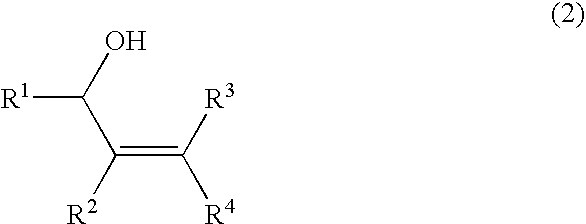Method for producing oxygen-containing compound
a technology of oxygen-containing compounds and catalysts, which is applied in the field of producing oxygen-containing compounds, can solve the problems of large amount of selenium dioxide used, occupational safety and health, and difficulty in recovering and reusing selenium dioxide catalysts, and achieves the effect of easy recovery and reus
- Summary
- Abstract
- Description
- Claims
- Application Information
AI Technical Summary
Benefits of technology
Problems solved by technology
Method used
Image
Examples
example 1
[0059] Into a 100 mL flask equipped with a magnetic rotor and a reflux condenser, 50 mg of selenium dioxide, 100 mg of 3,4-dihydroxybenzoic acid, 1 g of 1-butyl-3-methylimidazolium tetrafluoroborate and 1 g of 70 wt % aqueous tert-butylhydroperoxide were charged. The mixture was stirred and maintained for 30 minutes at an inner temperature of 40° C. After that, 1.5 g of methyl 3,3-dimethyl-2-(2-methyl-1-propenyl)cyclopropanecarboxylate was added to the mixture, and the resulting mixture was heated to an inner temperature of 60° C. To the mixture, 1.64 g of 70 wt % aqueous tert-butylhydroperoxide was added dropwise over 1 hour at the same temperature and the resulting mixture was stirred to effect the reaction for 5 hours at the same temperature. After completion of the reaction, the reaction mixture was cooled to room temperature. 10 g of n-hexane was added to the reaction mixture and the extracting treatment was carried out to obtain a n-hexane phase and an ionic liquid phase. The ...
example 2
[0063] After 1.5 g of the ionic liquid phase obtained in example 1 and 1.5 g of methyl 3,3-dimethyl-2-(2-methyl-1-propenyl)cyclopropanecarboxylate were charged into a 100 mL flask equipped with a magnetic rotor and a reflux condenser, the resulting mixture was heated to an inner temperature of 60° C. and 2.6 g of 70 wt % aqueous tert-butylhydroperoxide was added dropwise over 1 hour at the same temperature with stirring, and then the mixture was heated to an inner temperature of 80° C. and stirred to effect the reaction for 3 hours at the same temperature. After completion of the reaction, the reaction mixture was cooled to room temperature. 10 g of n-hexane was added to the reaction mixture and the extracting treatment was carried out to obtain a n-hexane phase and an ionic liquid phase. The ionic liquid phase was extracted two times by n-hexane and obtained n-hexane phase was mixed to the n-hexane phase obtained before to obtain an organic phase containing oxygen-containing compou...
example 3
[0067] Into a 100 mL flask equipped with a magnetic rotor and a reflux condenser, 50 mg of selenium dioxide, 100 mg of picoline, 1 g of 1-butyl-3-methylimidazolium tetrafluoroborate and 0.5 g of 70 wt % aqueous tert-butylhydroperoxide were charged. The mixture was stirred and maintained for 30 minutes at an inner temperature of 40° C. After that, 1.5 g of methyl 3,3-dimethyl-2-(2-methyl-1-propenyl)cyclopropanecarboxylate was added to the mixture, and the resulting mixture was heated to an inner temperature of 60° C. To the mixture, 2.2 g of 70 wt % aqueous tert-butylhydroperoxide was added dropwise over 1 hour at the same temperature with stirring. The resulting mixture was heated to an inner temperature of 80° C. and stirred to effect the reaction for 2 hours at the same temperature. After completion of the reaction, the reaction mixture was cooled to room temperature. 10 g of n-hexane was added to the reaction mixture and the extracting treatment was carried out to obtain a n-hexa...
PUM
| Property | Measurement | Unit |
|---|---|---|
| temperature | aaaaa | aaaaa |
| melting point | aaaaa | aaaaa |
| melting point | aaaaa | aaaaa |
Abstract
Description
Claims
Application Information
 Login to View More
Login to View More - R&D
- Intellectual Property
- Life Sciences
- Materials
- Tech Scout
- Unparalleled Data Quality
- Higher Quality Content
- 60% Fewer Hallucinations
Browse by: Latest US Patents, China's latest patents, Technical Efficacy Thesaurus, Application Domain, Technology Topic, Popular Technical Reports.
© 2025 PatSnap. All rights reserved.Legal|Privacy policy|Modern Slavery Act Transparency Statement|Sitemap|About US| Contact US: help@patsnap.com



